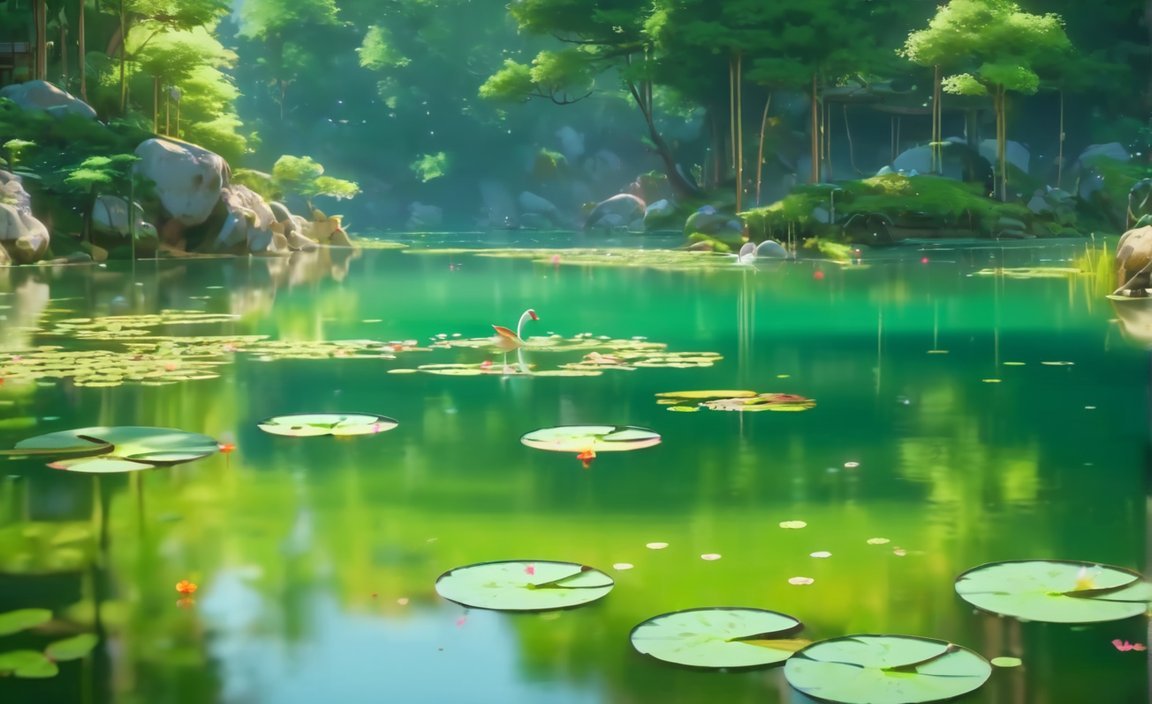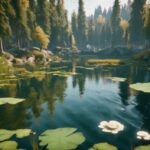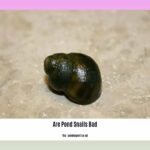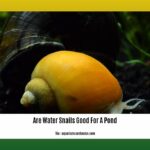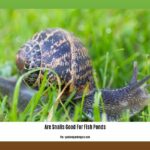Immerse yourself in the captivating world of aquatic ecosystems with our article, “Discover 5 Fascinating Pond Facts: Exploring Aquatic Ecosystems.” In this insightful piece, we delve into the wonders of ponds and uncover five intriguing facts that will leave you awestruck. From the remarkable biodiversity within these serene habitats to their crucial role in maintaining a healthy environment, join us on this journey as we unravel the secrets of ponds and shine a light on their significance in the natural world.

Key Takeaways:
- A pond is a smaller body of water than a lake, supporting a diverse range of wildlife including ducks, turtles, swans, small fish, and frogs.
- Ponds can be natural, formed by underwater springs, melting snow, or rainwater, or man-made.
- Ponds can have fresh, brackish, or salt water, and can be permanent or temporary, known as vernal ponds or ephemeral wetlands.
- Ponds are ecosystems where living and non-living things interact, providing favorable conditions for various plants and animals.
- Ponds have served different purposes throughout history, such as a source of food, farming, decoration, spirituality, and showcasing wealth.
5 Facts About Ponds
A Closer Look into Aquatic Ecosystems
Ponds are fascinating and often overlooked habitats that are teeming with life. From curious critters to diverse plant species, these aquatic ecosystems provide a unique environment for various organisms to thrive. Let’s dive into the intriguing world of ponds and uncover 5 facts about ponds that will leave you awestruck.
Fact 1: A Closer Look at Pond Life
Ponds are not just stagnant bodies of water; they are bustling communities bustling with an array of vibrant wildlife. Ducks, turtles, swans, small fish, and frogs are just a few of the fascinating creatures that call ponds their home[^1^]. As you explore the edges of a pond, you might spot ducks swimming gracefully, frogs croaking merrily, and turtles basking in the sun. These delightful inhabitants make ponds truly captivating ecosystems to observe.
Fact 2: Origins of Ponds
Ever wondered how ponds are formed? Well, some ponds come into existence naturally, while others are man-made. Natural ponds can be created by various means, including underwater springs, melting snow, or rainwater[^2^]. On the other hand, humans sometimes construct ponds for irrigation, aesthetic purposes, or even for recreational fishing. Regardless of their origins, each pond holds a unique story waiting to be discovered.
Fact 3: The Diversity of Ponds
Ponds can vary immensely in their water composition and longevity. They can be classified into different types based on their water source and salinity. Some ponds are freshwater, while others may contain brackish or salty water[^2^]. Additionally, ponds can be either permanent or temporary depending on the season and water source. Temporary ponds, also known as vernal ponds or ephemeral wetlands, thrive during certain times of the year, providing habitats for unique species[^2^][^3^]. The diversity within these mini-ecosystems is truly astounding.
Fact 4: The Magic of Pond Ecosystems
Ponds are more than just bodies of water; they are complete ecosystems where living and non-living components intricately interact with one another[^2^]. Think of ponds as a harmonious blend of plants, animals, and abiotic factors working together to create a delicate balance. These watery habitats support a wide variety of flora and fauna, acting as a treasure trove of biodiversity. From vital oxygen production to nutrient cycling, ponds play a significant ecological role that can’t be underestimated.
Fact 5: Ponds Throughout History
Ponds have played numerous roles throughout history, serving purposes beyond their ecological significance. They have been utilized as a source of food, farming, decoration, spirituality, and even as displays of wealth[^4^]. In ancient times, ponds provided communities with sustenance through fishing and served as crucial watering holes for livestock. Ponds have also been prized for their aesthetic value, often found in ornamental gardens and parks. Their tranquil waters have even been associated with spiritual practices and reflection.
Unlocking the Wonders of Ponds
Ponds may seem unassuming at first glance, but they hold a vast wealth of biological and historical importance. From the diverse array of life that inhabits them to their fascinating origins and cultural significance, ponds have an undeniable allure that captivates both scientists and nature enthusiasts alike. So, the next time you come across a shimmering pond, take a moment to appreciate the beauty and wonder that lie within its depths.
Remember, every pond has its own unique story to tell. Now that you know these 5 fascinating pond facts, it’s time to dive deeper into the enchanting world of aquatic ecosystems.
Did you know that marine biology is full of fascinating facts? Check out these 5 facts about marine biology and be amazed by the wonders beneath the ocean’s surface. 5 facts about marine biology
Explore the secrets of marine life with these 5 captivating facts. From colorful coral reefs to majestic whales, there is so much to discover about the incredible creatures that inhabit our oceans. Dive into the world of marine life and find out more here.
Curious about the amazing diversity of ocean animals? Discover 5 fascinating facts about them, from the peculiar behavior of octopuses to the astonishing speed of sailfish. Prepare to be intrigued and click here to unravel the mysteries of ocean animals.
Prepare to be mesmerized by the wonders of ocean life. With its vastness and beauty, the ocean houses an abundance of incredible creatures and ecosystems. Dive in to learn 5 fascinating facts about ocean life and be in awe of its magnificence.
3. Ponds Provide Important Habitat and Breeding Grounds for Various Organisms
Ponds are not just serene bodies of water; they are teeming with life and play a vital role in supporting biodiversity. These freshwater habitats serve as important habitat and breeding grounds for a diverse range of organisms, contributing to the overall health of ecosystems. Let’s dive deeper into the fascinating world of ponds and discover why they are so crucial for various species.
Amphibians: A Pond’s Preferred Residents
Amphibians are a key group of animals that heavily rely on ponds for their life cycles. These include the common frog, common toad, and smooth newt. Ponds provide these amphibians with breeding grounds, sources of food, and shelter. It’s fascinating to witness their metamorphosis from tadpoles to adult amphibians, all within the confines of a pond.
Larger Animals Find Refuge in Garden Ponds
Even larger animals find garden ponds irresistible. Creatures like the blackbird and other garden birds, the grass snake, and the fox are known to visit these ponds for a variety of reasons. They use garden ponds as a source of drinking water, for bathing, and even for hunting. Having a garden pond can attract a rich variety of wildlife right to your doorstep.
The Microcosm of Insects and Other Invertebrates
Ponds are bustling ecosystems, buzzing with life in the form of insects and other invertebrates. These include the common pond skater, lesser water boatman, and common backswimmer. Insects like these contribute to the pond ecosystem by participating in nutrient cycling and acting as a significant food source for larger animals. They are essential players in maintaining the delicate balance within the pond.
Nurturing Biodiversity Through Ponds
Research has shown that ponds support more freshwater life than any other UK freshwater habitat[^1^]. They provide essential habitat and breeding grounds for numerous species, including amphibians, insects, and plants. Ponds with a diverse range of features tend to host a greater variety of wildlife[^1^]. By nurturing the biodiversity found within ponds, we can help maintain the delicate balance of ecosystems and ensure the survival of various species.
Conservation and Creation: The Key to Preserving Ponds
Due to the vital role that ponds play in supporting biodiversity, it is crucial to protect existing ponds and create new ones. Ponds provide opportunities for species to thrive and contribute to overall ecosystem health. Creating ponds in gardens and agricultural landscapes can help provide oases of wildlife and support the conservation of various species[^2^]. By taking steps to conserve and create ponds, we can have a significant impact on preserving these invaluable habitats.
Key Takeaways:
– Ponds serve as important habitat and breeding grounds for a diverse range of organisms.
– Amphibians, like common frogs and smooth newts, rely heavily on ponds for their life cycles.
– Garden ponds attract larger animals such as birds, snakes, and foxes, providing them with water, bathing, and hunting opportunities.
– Insects and other invertebrates, such as pond skaters and water boatmen, play vital roles in nutrient cycling and serve as a food source for other animals.
– Ponds support more freshwater life than any other UK freshwater habitat and contribute significantly to biodiversity.
– Conserving existing ponds and creating new ones is crucial for preserving these valuable habitats and supporting various species[^1^][^2^].
References:
[^1^]: Pond Life: Facts about Pond Habitats, Plants and Animals
[^2^]: Ponds and Lakes: A Journey Through the Life Aquatic
4. Ponds can vary in size, depth, and water composition, resulting in different types of ponds
Ponds are fascinating ecosystems that come in a wide range of sizes, depths, and water compositions. These variations give rise to different types of ponds, each with its own unique characteristics and significance. Let’s dive deeper into these intriguing facts about ponds and explore the diversity they offer.
Types of Ponds
1. Varying Sizes: Ponds can range from small, intimate pools to expansive bodies of water. They can occupy as little as 1 square meter or extend up to 2 hectares in size. The dimensions of a pond depend on factors such as the availability of space, local topography, and the purpose for which it was created.
2. Varied Depths: Ponds can have varying depths, with some featuring shallow bottoms while others plunge into deeper waters. The depth of a pond often correlates with its size and purpose. Small garden ponds are typically shallower, providing safe habitats for smaller aquatic organisms, while larger fish ponds may have deeper sections to accommodate fish species that prefer deeper waters.
3. Diverse Water Compositions: One of the most fascinating aspects of ponds is the wide array of water compositions they can possess. Some ponds are freshwater, while others may contain brackish or salty water. The composition is influenced by factors such as underground springs, rainfall, geographical location, and proximity to the sea. The unique water compositions contribute to the diversity of plant and animal life that thrive in different types of ponds.
Key Takeaways:
- Ponds come in various sizes, ranging from small pools to larger bodies of water.
- The depth of a pond can vary, catering to the needs of different aquatic species.
- Ponds can possess different water compositions, including freshwater, brackish, or salty water.
Sources:
1. Freshwater Habitats Trust: Pond Creation and Restoration
2. Nature, ResearchGate: Pond Management
Remember, it’s crucial to understand the characteristics and differences among ponds to appreciate their significance in our environment. Whether small or large, shallow or deep, and freshwater or brackish, each type of pond offers a unique ecosystem that deserves our attention and conservation efforts. So, let’s continue marveling at these incredible aquatic habitats and work towards their preservation.
5 Fascinating Pond Facts: Exploring Aquatic Ecosystems
Ponds, with their serene and tranquil allure, are not just bodies of water – they are complex ecosystems teeming with life. Delicate in their balance, these watery habitats face threats from human activities that require urgent conservation efforts. In this article, we will delve into five fascinating facts about ponds, shedding light on their importance and the need to safeguard their delicate ecosystems from harm.
Ponds: Biodiversity Reservoirs Facing Human-Induced Perils
The Impact of Chemical Pollution: Ponds are facing threats from human activities, particularly chemical pollution resulting from modern farming methods. Pesticides and fertilizers used in agriculture can find their way into pond waters, disrupting the balance of the ecosystem. These chemicals can lead to harmful algal blooms, oxygen depletion, and ultimately the decline of fish and other aquatic species. [1]
Neonicotinoid and Microplastics Pollution: Human activities also pose threats to pond biodiversity through the pollution caused by neonicotinoid pesticides and microplastics. Neonicotinoids, commonly used in agriculture, can harm aquatic insects, negatively impacting the entire food chain in the pond. Microplastics, tiny particles of plastic waste, accumulate in pond waters and are ingested by organisms, causing widespread harm. [2]
Invasion of Non-Native Species: Ponds are vulnerable to invasive species colonization due to human activities like pet release and intentional introduction. These non-native species can outcompete native flora and fauna, disrupting the delicate balance and biodiversity of the pond ecosystem. It is essential to prevent the introduction of invasive species and take measures to control their spread.
Altered Pond Connectivity: Changes in the connectivity of pondscapes due to human activities can also have significant impacts on pond biodiversity. Isolated ponds face challenges in maintaining diverse populations, as movement of species between ponds is restricted. This loss of connectivity can lead to genetic isolation, reducing the resilience of pond ecosystems in the face of environmental changes.
Addressing Knowledge Gaps for Conservation: To effectively conserve and manage pond ecosystems, it is crucial to address gaps in our understanding of their complexity and functioning. Research-led conservation efforts can help bridge these gaps and develop science-based strategies for the protection and restoration of ponds. By expanding our knowledge, we can make informed decisions and implement necessary measures to safeguard these vital habitats.
Key Takeaways:
- Ponds face threats from chemical pollution, including pesticides and fertilizers from modern farming practices.
- Neonicotinoid pesticides and microplastics pose significant risks to pond biodiversity.
- Invasion of non-native species can disrupt the delicate balance and biodiversity of pond ecosystems.
- Changes in pondscape connectivity affect species movement and genetic diversity.
- Addressing knowledge gaps through research is essential for effective conservation of ponds.
Sources:
1. Pond ecology and conservation: research priorities and knowledge
2. The ecological role of ponds in a changing world

FAQ
Q1: What is a pond?
A1: A pond is a body of water smaller than a lake that supports a wide range of wildlife and provides habitat conditions for many types of plants and animals to thrive.
Q2: How are ponds formed?
A2: Ponds can be formed naturally by underwater springs, melting snow, or rainwater, while others are man-made.
Q3: What types of animals can be found in ponds?
A3: Ponds support a diverse range of wildlife, including ducks, turtles, swans, small fish, frogs, garden birds, grass snakes, and foxes, among others.
Q4: Why are ponds important for biodiversity?
A4: Ponds support more freshwater life than any other UK freshwater habitat. They provide essential habitat and breeding grounds for numerous species, including amphibians, insects, and plants.
Q5: How can we contribute to the conservation of ponds?
A5: To contribute to the conservation of ponds, it is important to protect existing ponds and create new ones. Creating ponds in gardens and agricultural landscapes can help provide oases of wildlife and support the conservation of various species.
- Senior at What Age: Benefits & Eligibility Guide - March 29, 2025
- Unlocking Senior Benefits: How Old is a Senior? Your Complete Guide - March 29, 2025
- Master Russian Politeness:A Guide to Saying Please - March 29, 2025
